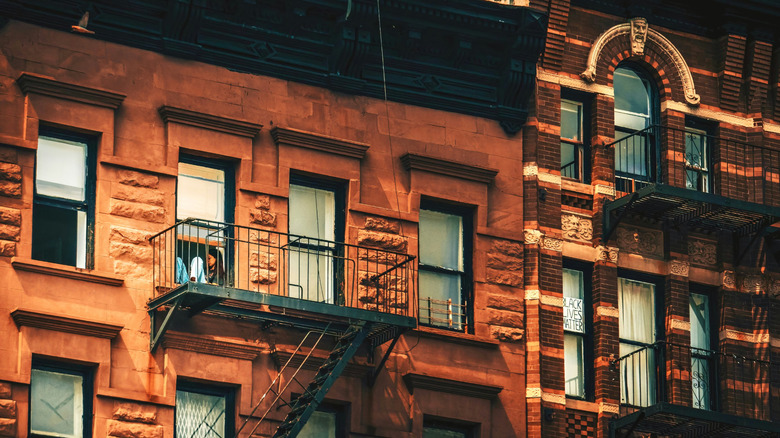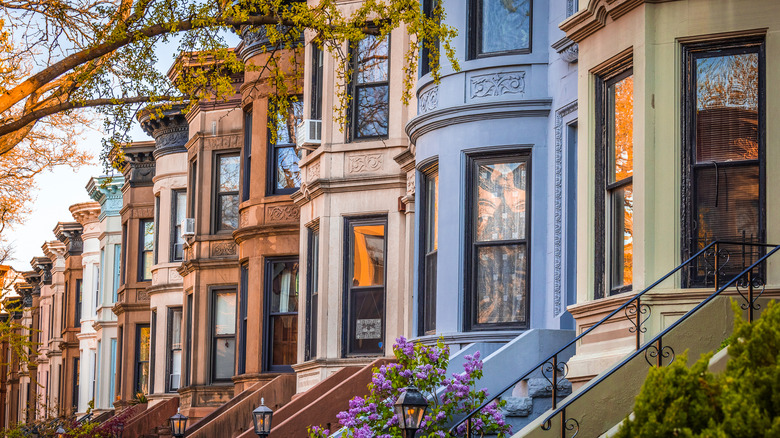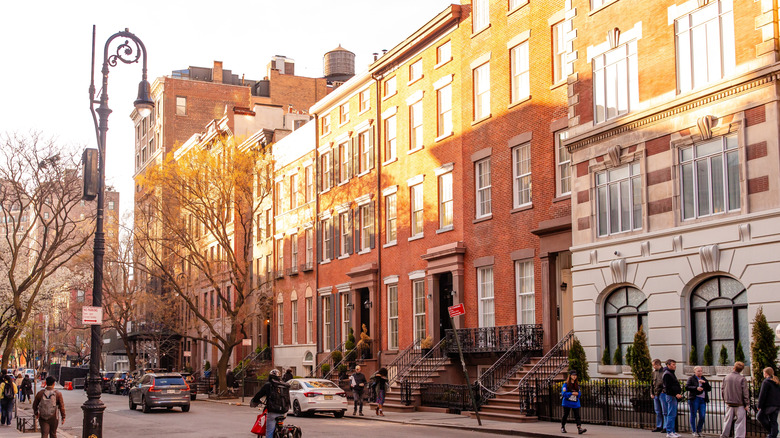What Makes The Architecture Of NY Brownstones So Iconic?
A single brick costs just a few dollars, but when grouped together to form the iconic faces of New York City's brownstones, bricks are worth millions. The word "brownstone" brings to mind an image of historic townhomes lining the streets of New York's most iconic neighborhoods, but what does it actually mean? Charles Lockwood, foremost expert on brownstones and author of "Bricks and Brownstone: The New York Row House 1783-1929," defined brownstone as "a soft, close-grained triassic sandstone or freestone" in an interview with Brownstoner. Initially, entire buildings were constructed from solid brownstone, but over time it became more economical to use them as a decorative face.
Most of the brownstone buildings that make up the cityscape of New York were constructed in the 19th and early 20th centuries. Surrounded by skyscrapers, car traffic, and the trappings of modernity, these buildings preserve a snapshot of the past. With New York City mayoral candidate Zohran Mamdani planning to make NYC a more affordable city to live in, perhaps you can snag a brownstone for yourself, adding your name to a long list of historic ownership.
Brownstones have historic and architectural significance
Before buying a brownstone, you should understand their long history in New York City and their architectural significance, both of which are part of their appeal. Brownstones joined the New York City skyline in earnest during the 1800s, with the buildings styled after English terraced houses. In a growing city, brownstone townhomes were the perfect mix of space-saving verticality and status symbol — a mix that remains to present day.
In the early days of brownstone's popularity, it served as an accent to the red brick Federal and Greek Revival homes, but by the mid-19th century, it came to stand on its own. These first brownstone row homes were built in the popular style of the time, Romantic Classicism, which strived to capture the seamless beauty of nature. With the arrival of the Industrial Revolution, workers could carve out brownstone from quarries faster, which helped drive down the price of homes built during the latter part of the brownstone's history. This made brownstone townhomes available to the middle class, only increasing their popularity. Brownstones remain popular for their iconic exteriors as well as their interior layouts, which often feature winding staircases and high ceilings.
The iconic locations of brownstones contribute to their desirability
Even if you are not a New Yorker, you're probably familiar with the city's iconic neighborhoods, including Brooklyn Heights, Park Slope, and Harlem — the places where you're most likely to find a brownstone. Fans of Cher in the 1987 romantic comedy "Moonstruck" will be familiar with the Brooklyn Heights Historic District, home of the brownstone featured in the film — which sold for $11 million in 2022.
These neighborhoods are desirable for their proximity to central New York City and for their cultural significance. As New York City's first suburb, Brooklyn Heights hosted artists and writers of the 1960s and played a central role in fostering the city's LGBTQ community. Park Slope's Prospect Park offers greenery and respite in America's most hectic city, and the neighborhood serves as an aesthetic backdrop for photographers. Known for being a centerpiece of African American culture, Harlem has a vibrant atmosphere that draws in people from across the world. The brownstones in these neighborhoods are not just beautiful homes — they're the key to the center of metropolitan culture.


